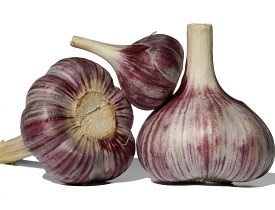Garden Pests: Garlic is Your Enemy!
 Garlic isn’t just for keeping vampires away. Pungent garlic also controls garden pests in at least three proven ways, according to several leading garden experts and authors.
Garlic isn’t just for keeping vampires away. Pungent garlic also controls garden pests in at least three proven ways, according to several leading garden experts and authors.
Companion planting with garlic
You may not want a companion with garlic breath, but plenty of plants are happy with garlic as a companion. The pungent odor keeps insects from detecting the sweet smell of roses, peaches and more. Cornell Cooperative Extension experts note that pest deterrence through companion planting is difficult to prove, but said there is substantial anecdotal evidence of success.
In his Giant Book of Garden Solutions, plant expert Jerry Baker recommends planting garlic in rose beds to ward off cane borers, aphids, rose chafers and Japanese beetles. To repel peach tree borers, Baker recommends planting a ring of garlic around a peach tree trunk, but the garlic and the tree must be planted at the same time.
In The Garden Pests and Diseases Specialist, David Squire suggests planting garlic around carrots to mask the carrot smell and keep carrot flies away. Leeks and onions also help.
According to North Carolina Cooperative Extension, sowing garlic around celery and lettuce deters aphids. Planting garlic between tomato plants can keep away red spider mites, claims Cornell Cooperative Extension. The Cornell experts also recommend planting garlic near cabbage to deter cabbage looper, cabbage maggot and imported cabbageworm. They also suggest garlic for keeping rabbits, slugs and snails away from the veggie patch.
Garlic can also help in other ways. The North Carolina advisors suggest that companion plantings of garlic can improve the growth and flavor of beets, cabbage and peas. On the other hand, they warn that garlic might inhibit the growth of beans if planted too close.
Garlic pesticides
Garlic also forms the basis of effective, organic pesticides to spray on plants and ward off bugs. Garlic is often used in conjunction with hot peppers as a natural pest-killing double whammy. Such bug sprays are commercially available or can be homemade.
Studies have shown success with garlic pesticides, for both mosquito larvae and many garden pests. However, as with companion planting, most evidence regarding garlic pest control is anecdotal. Garlic-based pesticides can kill off some bugs, but are typically most effective as a preventive measure. Use before insects appear on crops that have fallen victim to a certain species in previous seasons.
Natural pesticide recipes
Baker offers two recipes for repelling a wide variety of bugs throughout the garden.
- Puree 3 hot green peppers, 3 garlic cloves and 1 small onion. Add 1 tablespoon liquid dish soap and 3 cups water. Let steep for a day, then strain through cheesecloth.
- Puree 4 cloves garlic, 1 small onion and 1 small jalapeno pepper. Steep in 1 quart water for two hours. Strain and mix with 1 teaspoon Murphy’s Oil Soap and 1 teaspoon vegetable oil.
Either mixture can be mist sprayed onto plants, coating the tops and bottoms of leaves.
To specifically target vegetables, Baker suggests mixing 6 cloves crushed garlic, 1 small onion, 1 tablespoon each cayenne pepper and liquid dish soap with 1 quart of warm water. Strain and mist onto vegetable leaves, covering both sides.
For more specialized mixtures, Baker advises preparing a cup of garlic oil and keeping it in the refrigerator. Mince 1 garlic bulb into 1 cup vegetable oil, then let the tincture steep in the fridge for a couple of days. “If the aroma is so strong that you take a step back, you’re ready to roll,” he writes. Otherwise, add another half bulb of garlic and wait another day. Filter the pungent oil into another jar and use in a variety of garlic pesticides.
To control aphids, Baker recommends diluting 1 tablespoon garlic oil with 3 drops of liquid dish soap in 1 quart of water. Use a mist sprayer to keep aphids off plants.
To prevent or get rid of potato beetles, cabbage moths and cabbage loopers, Baker proposes boiling 1 clove garlic in 1 cup water, along with 4 cloves and a handful of wild mustard leaves. Let the “tea” cool, then mist spray onto potato and cabbage leaves.
Fern Marshall Bradley offers several warnings regarding garlic sprays in her book, Rodale’s Vegetable Garden Problem Solver. First, a safety tip: wear gloves and avoid getting concentrated garlic juice on skin or eyes, as it can be a serious irritant.
Also, garlic sprays might kill beneficial insects, as well as the bugs you're targeting. For example, in attempting to kill off aphids, you might kill beneficial insects that are better aphid killers.
Garlic fungicide recipes
Several scientific studies also suggest garlic has proven success in fighting off nasty fungal diseases. A 2008 report in the European Journal of Plant Pathology found garlic effective against tomato leaf blight and tuber blight. Baker, dubbed “America’s Master Gardener,” writes that “there’s nothin’ fungi hate more than garlic.”
Baker suggests boiling 4 bulbs crushed garlic and 1/2 cup baking soda in 1 gallon water. Cool to room temperature, strain into a watering can and slowly soak the ground around the infected plants so the water soaks in really deeply. Dump out the crushed garlic and slowly work it into the soil.
Others use pure concentrated garlic essential oil, and commercial garlic-based fungicides also are available.
Of course, garlic is not the magic bullet for all fungi. Garlic rust and other fungal diseases are a major nuisance for garlic farmers.
Updated January 15, 2018.
Looking for a Pro? Call us (866) 441-6648

Landscaping Average Costs
Landscapers Experiences

Rock Landscaping Adds Curb Appeal To An Arizona Home

Leaf Removal This Year, More Landscape Work Next Summer



